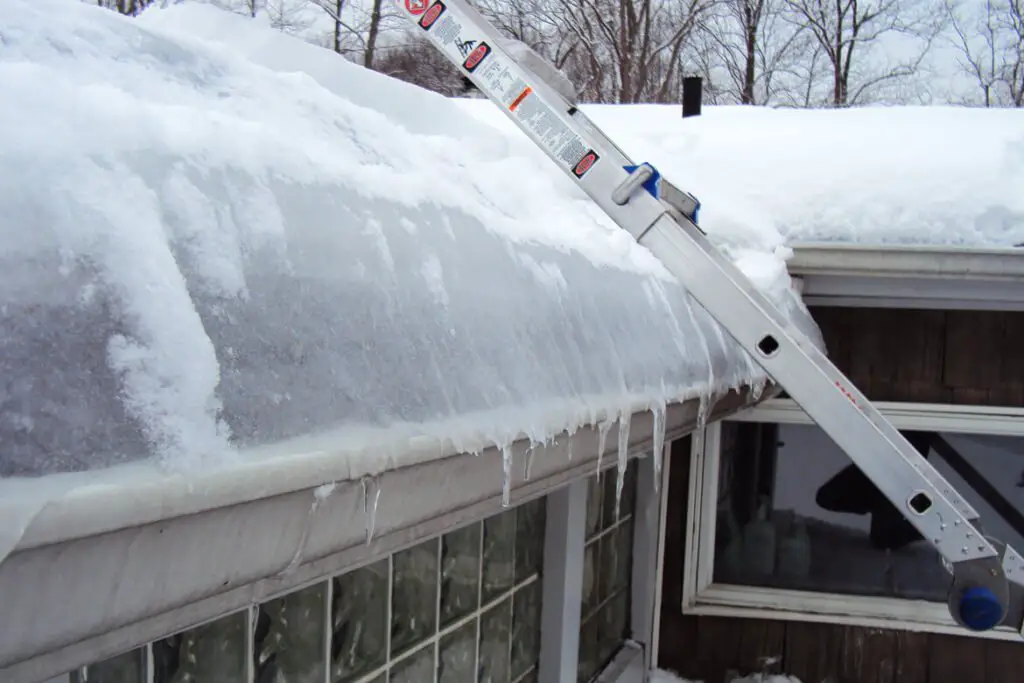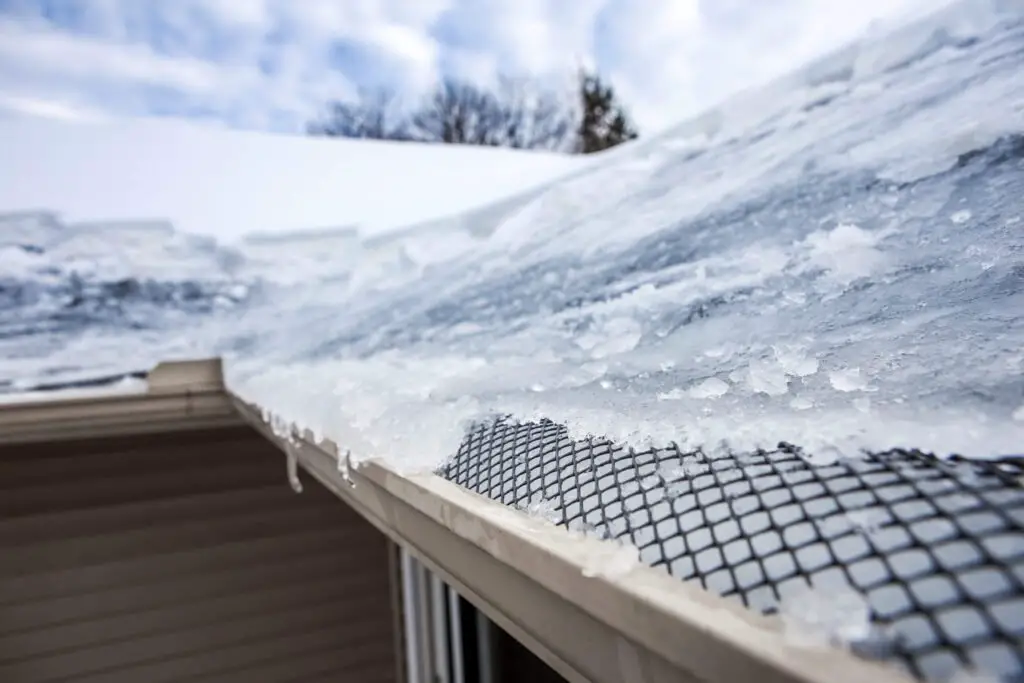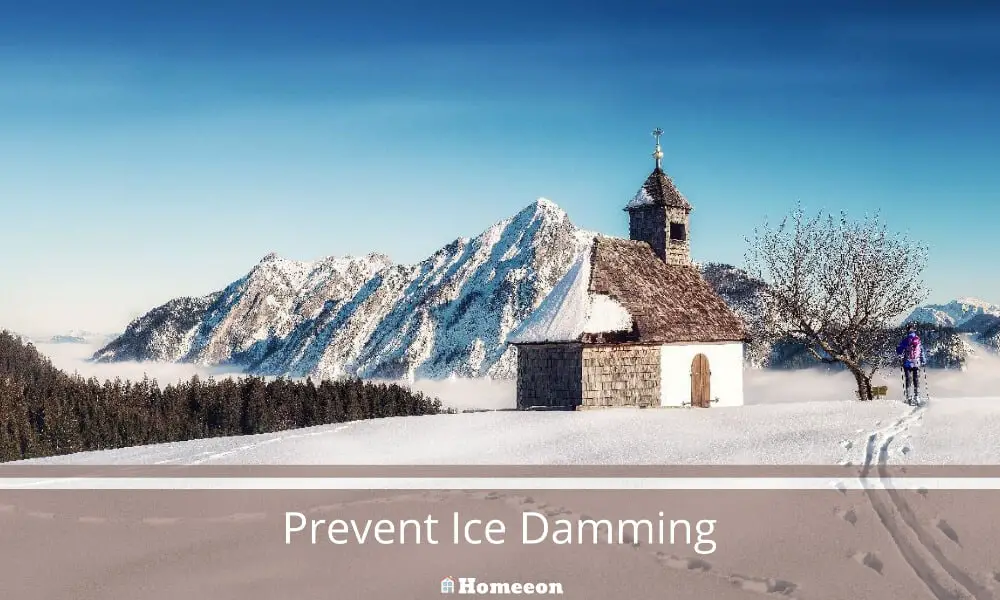Last Updated on August 15, 2023 By Emma W. Thomas
Prevent ice damming by maintaining attic temperature around 32°F (0°C) and ensuring consistent roof ventilation. Insulate with an R-value of 49, and seal air leaks. Clean gutters regularly. Use roof rakes and heat cables as needed. These measures reduce the risk of ice dams forming.
How To Prevent Ice Damming

You can combine the following factors to prevent ice damming;
- Have proper ventilation under your roof deck to keep the cooler outside air circulating via the attic and to prevent it from warming beyond the freezing point
- Block any sources of heat that may lead to attic temperatures rising
- Insulate the ceiling under the attic to prevent warm air from going up
1. Ventilation
Ventilating your attic space ensures that cold, outside air circulates here preventing the temperature from rising above freezing point. The snow on your roof remains intact and does not melt. You can improve attic ventilation by;
1. Creating a continuous airflow from the soffit to the peak of the roof, where there is insulation between rafters
2. Use a gable or soffit for an air inlet and several conventional vents for an outlet if a soffit-and-ridge system is not desirable. Sufficient ventilation of the attic keeps the roof deck cool and prevents the snow on the roof from melting and also stops damming before it happens.
2. Insulation
Insulating the ceiling in your living spaces beneath the attic also lowers the temperature against the roof deck. If your loft is open, protect its floor or the rafter spaces if you have a finished ceiling against the roof.
Insulating your space prevents heat from rising and heating the roof deck enough to melt the snow. You can also seal any gaps around chimneys and plumbing pipes which can be a source of heat flow into the upper floor. Proper insulation prevents ice dams and also minimizes energy costs. Combine ventilation and insulation for better results
3. Blocking Heat Sources
There may be heat sources in the attic without your knowledge that occur due to older recessed lights mounted on the attic floor. These lights can radiate large amounts of heat into the attic which can make the air temperature rise beyond that freezing point.
There may also be heat sources from clothes dryer vents, kitchen exhaust fans, poorly ventilated bathrooms, or un-insulated HVAC ductwork.
How To Prevent Ice Damming Using Electric Heat Cable
Although improved ventilation and reduction of heat sources against the roof surface are among the best methods of preventing ice dams, they are sometimes not practical. You can install an electric heat cable along the gutters and roofline edge.
If the heating cable is looped in a zig-zag pattern along the roof edge, it will prevent the melting water from freezing once it reaches the eaves. The liquid water will instead flow to the ground. Heat cable prevents ice dams if you fix it properly. It would help if you were careful when installing a heat cable to prevent water and electricity from coming into contact, which can be risky.
Follow the manufacturer’s instructions to ensure the cable remains safe. Ensure that your gutters are free of fall leaves before the snow comes for melted snow to flow out properly.
How To Eliminate Ice Dams
Prevention of ice damming is best done during summer, fall, or spring. But, if you didn’t undertake these preventive measures and you have a problem with ice dams during winter, then you can minimize the issues by;
1. Using A Roof Rake
Ice dams occur quickly after heavy snow due to the insulating properties of snow. You can use a long-handle roof rake to remove the ice from the roof edge. Using a rake to remove snow is safer than getting onto the roof during winter. Be sure to use light pressure and don’t scrap the shingles too hard.
2. Flaking The Ice
Although it is not advisable to climb onto the roof, you can chip away some ice using your hands by reaching the roof space with an extension ladder. Don’t remove the whole ice dam as doing this could open a channel for more meltwater to flow off the roof.
You can repeat this method any time ice builds up, blocking the opening you have made. Use a small hatchet, a chisel, or an ice pick. But avoid the method if the ice dam is too high for you to reach safely.
3. Using Calcium Chloride
Calcium Chloride or any similar ice-melt product can be useful in getting rid of the ice dam. Apply the substance onto the ice and avoid putting salt in a pantyhose as it may not work too well. The method also takes a lot of salt and may cause the socks to rip apart.
4. Hiring An Expert
When you cannot handle the ice dam build-up, it is advisable to hire a professional. You can call a company specializing in the service. You can also contact a roofing contractor since they offer this service during winter as there is little roofing work.
Experts are usually insured, and they will remove ice damming with their special tools like a low-pressure / high-temperature steamer that melts ice and snow from the roof. Although hiring a professional may be costly, it can prevent significant damage to your home.
What Causes Ice Damming?
Ice damming occurs after a heavy snowfall and when warm air on the upper floor causes the roof to heat up and the snow to melt. The ice locks in meltwater, causing it to seep back up under shingles. This meltwater trickles into your house through the roof and causes wet and stained walls and ceilings as well as peeling of paint and rot.
Why are Ice Dams Bad?
Ice dams can wreak havoc on homeowners, causing extensive damage to both the exterior and interior of homes. While a hanging icicle might possess a sleek ice sculpture-like appeal, beauty becomes tarnished when accounting for resultant destruction. Here are the top reasons why ice dams are horrendous:
1. Roof Damage:
The freezing and thawing of ice within ice dams can cause significant shingle damage, making your roof prone to leaks. This sustained assault may lead to unsustainable repair costs, or in severe cases, necessitate a full roof replacement.
2. Fascia and Gutter Destruction:
Ice dams can besiege the fascia and gutters. The heavy weight of the ice can cause gutters to pull away from the house or collapse entirely, leaving your home without adequate drainage system against precipitation.
3. Damage to Attics and Ceilings:
Ice dams can lead to water seepage into your house, damaging attics and ceilings. This can result in ruined insulation, soggy drywall, and damaged plaster, requiring extensive cleanup and expensive repairs.
4. Mold and Mildew Growth:
Warm, damp conditions caused by ice dams provide an inviting environment for mold and mildew. This can exacerbate allergies and create health problems for household occupants.
5. Increased Energy Costs:
As ice dams damage your insulation, your home becomes less energy-efficient, leading to increased heating costs during winter months.
Consequences of Ice Dam Formation
| Consequences | Description |
|---|---|
| Roof Damage | Causes shingle damage, leading to leaks or requiring a roof replacement |
| Fascia and Gutter Destruction | Causes gutters to pull away or collapse due to the heaviness of ice |
| Damage to Attics and Ceilings | Seepage ruins insulation, damages drywall and plaster |
| Mold and Mildew Growth | Creates conditions promoting mould and mildew growth |
| Increased Energy Costs | Damaged insulation results in increased heating costs |
Can Soffit Vents Prevent Ice Dams?

Yes, you can prevent ice dams from forming by keeping the whole roof cold. You will need to block all air leaks that lead to the attic for your living space below. Doing this will increase the thickness of insulation on the roof space. You can also install a ridge vent system and a continuous soffit.
Can You Put Ice Melt On Your Roof?
If you put ice melt and rock salt on your roof directly, it will spoil the shingles. You can instead fill socks with ice melt and salt, tie them off, and stick a few in your gutters as this will help clear out ice dams.
References:
https://www.michigan.gov/miready/be-informed/winter-prep/preventing-roof-ice-dams
https://www.thisoldhouse.com/roofing/21017660/how-to-get-rid-of-ice-dams
Emma is a graduate of Domestic Science or Family and Consumer Sciences (Home Economics) from the University of Wisconsin. She has 7 years of experience Working with the strategic section of BestBuy and now writing full-time for Homeeon.
From Managing the Home, Interiors, Cleaning, and Exteriors to Gardening and everything about Making A Home Liveable – is her passion and this Homeeon is the result of this.
Emma loves decorating her home with the best stuff found online. She cares about quality over anything and writes reviews about them here in Homeeon. Get in touch with her over Pinterest.
Keep reading her blogs.

